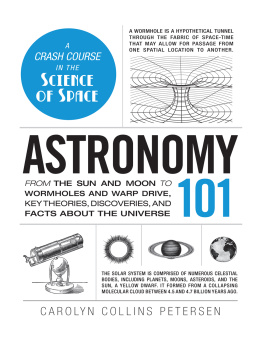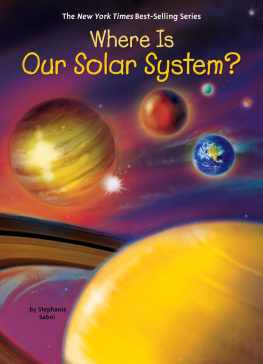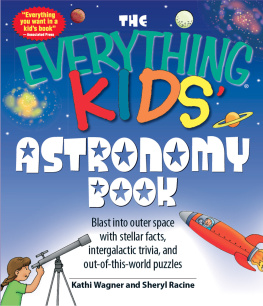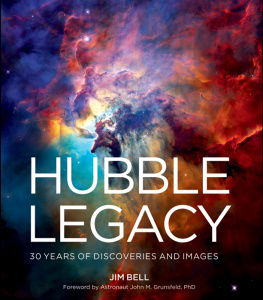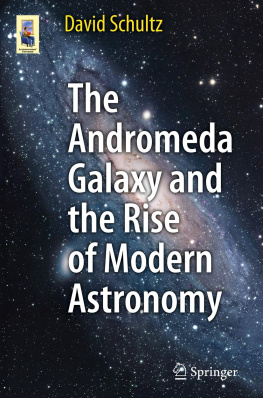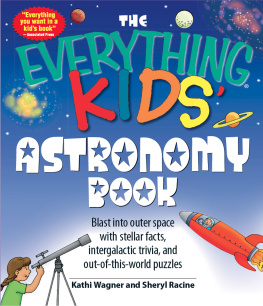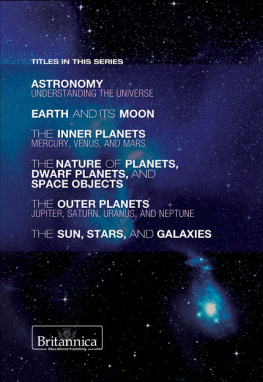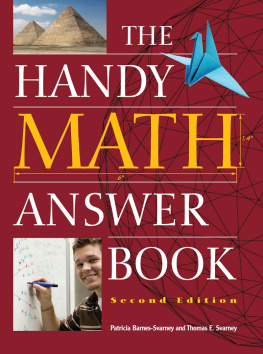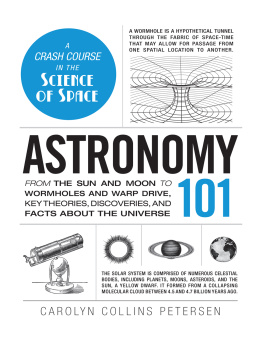To my many astronomy teachers. You promised me the Moon, planets, stars, and galaxies and the universe delivered!
INTRODUCTION
Welcome to Astronomy 101 and one of the most fascinating sciences in the universe! Whether youre familiar with the night sky and want to learn more about whats out there or just beginning your cosmic journey of understanding, theres something here to teach and inspire you.
Ive been into astronomy since I was a small child when I would go out with my parents to see what was up out there. I grew up wanting to become an astronaut and eventually spent time in college studying a lot of astronomy and planetary science. In the early part of my career I did astronomy research (mostly into comets), and that experience taught me there is nothing quite so fascinating as standing (or sitting) in front of the cosmos, open to new discoveries in space! Nowadays, I spend my time communicating astronomy to the public because I want others to experience the thrill of wonder and discovery that keeps astronomers going. I often give presentations about astronomy on cruise ships and other public places, and the questions people ask about the stars and planets are always fascinating and well thought out. It shows me that the love of the stars is bred into all of usand makes us want to know more about the cosmos.
In Astronomy 101, you get a taste of the cosmos. Astronomy is the scientific study of objects in the universe and the events that shape them. It is one of the oldest sciences and dates back to a point in human history when people first looked up at the sky and began to wonder about what they saw. Astronomy tells how the universe works by looking at what it contains. The cosmos is populated with stars, planets, galaxies, and galaxy clusters, and these are all governed by measurable physical laws and forces.
Each topic in this book gives you a taste of the subject it covers, from planets out to the most distant objects in the universe, introducing you to some of the people who have done astronomy, and venturing into some far out topics, such as extraterrestrial life and the science-fiction universes familiar to TV viewers, moviegoers, video gamers, and readers. Throughout the book, Ive woven in some basic concepts about astronomy and space, such as how orbits work and how to calculate distances in space.
Finally, although this isnt a how to book, in the final chapter, I leave you with a few thoughts about how to go about exploring the universe from your backyard and how we can all work together to mitigate light pollutionthe scourge of all sky gazers.
You can read this book from start to finish, or pick and choose the topics you want to read. Each one gives you a unique insight into the endlessly fascinating universe. And, if what you read spurs you on to more investigation, the reference section at the back points you to further reading.
Why Do People Do Astronomy?
The astronomer Carl Sagan once said that modern people are descendants of astronomers. Humans have always been sky watchers. Our earliest ancestors connected the motions of the Sun, Moon, and stars to the passage of time and the yearly change of seasons. Eventually, they learned to predict and chart celestial motions. They used that information to create timepieces and calendars. Accurate knowledge of the sky has always helped navigators find their way around, whether across an ocean or in deep space.
Humanitys fascination with the sky may have begun with shepherds, farmers, and navigators using the sky for daily needs, but today that interest has blossomed into a science. Professional astronomers use advanced technology and techniques to measure and chart objects and events very precisely. New discoveries come constantly, adding to a priceless treasury of knowledge about the universe and our place in it. In addition, the tools and technologies of astronomy and space exploration find their way into our technologies. If you fly in a plane, use a smartphone, have surgery, surf the Internet, shop for clothes, eat food, ride in a car, or any of the countless things you do each day, you use technology that in some way derived from astronomy and space science.
In my childhood I was enthralled with a 1927 poem written by American writer Max Ehrmann, Desiderata. My favorite line from it is: You are a child of the universe, no less than the trees and the stars; you have a right to be here. Thats why I draw a link between space and our DNA. All living things are a direct result of the processes that created the cosmos, built the galaxies, created and destroyed stars, and formed planets. We are, in many senses of the term, star stuff. Every atom of every living thing on Earth originated in space, and its poetic and delightful that we evolved to look back out at the light from stars that will eventually contribute their own stuff to create other stars, planets, and maybe even life. Thats why I can say that a love of the stars is woven into our DNA. Whether were professional astronomers or casual sky gazers, thats what draws our attention back to the depths of space. Its where we came from.
Welcome home!
ASTRONOMY LINGO
Throughout this book I use some astro-lingo, so lets look at a few definitions that will help you understand the language.
DISTANCE
Distances in astronomy get very large very fast. Astronomers use the term astronomical unit (shortened to AU) to define the distance between Earth and the Sun. Its equivalent to 149 million kilometers (93 million miles). (Astronomy is done in metric units.) So, for distances inside the solar system, we tend to use AU. For example, Jupiter (depending on where it is in its orbit) is 5.2 AU away from the Sun, which is a distance of 774.8 million kilometers (483.6 million miles).
In interstellar space, we use other units. The light-year (shortened to ly) comes from multiplying the speed of light, 300,000 kilometers per second, by the total seconds in a year. The result is the distance light travels in a year: 9.5 trillion kilometers. The nearest star is 4.2 light-years away from us. That means that its four times 9.5 trillion kilometers, which is a huge number. Its easier to say that the star is 4.2 light-years away.
Astronomers also use the term parsec (or pc for short). One parsec equals 3.26 light-years. The famous Pleiades star cluster is around 150 parsecs (about 350460 light-years) away. The nearest spiral galaxy, called the Andromeda Galaxy, is about 767 kiloparsecs or 2.5 million light-years from us.
Really huge distances are measured in terms of megaparsecs (millions of parsecs, or Mpc). The closest cluster of galaxies to our own Milky Way Galaxy lies about sixteen megaparsecs, or nearly 59 million light-years, away. The very largest distances are measured in units of gigaparsecs (billions of parsecs, Gpc). The limit of the visible universe lies about 14 Gpc away from us (about 45.7 billion light-years).
LIGHT
Light is the most basic property we study in astronomy. Studying the light emitted, reflected, or absorbed by an object tells a great deal about the object. The speed of light is the fastest velocity that anything can move in the universe. It is generally stated as 299,792,458 meters (186,282 miles) per second, in a vacuum. It has been measured very accurately and is the standard that astronomers and physicists use. However, as light passes through water, for example, it slows down to 229,600,000 meters (140,000 miles) per second. The letter

